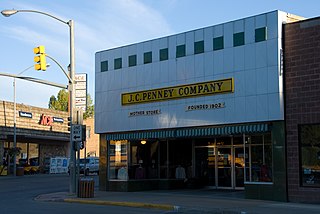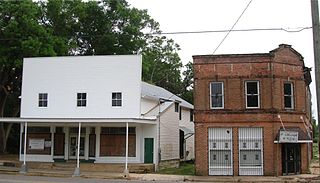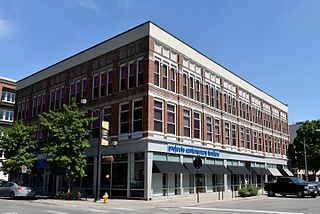
The Fairlie–Poplar Historic District is part of the central business district in downtown Atlanta. It is named for the two streets that cross at its center, northeast-only Fairlie and southeast-only Poplar. Fairlie–Poplar is immediately north of Five Points, the definitive center point and longtime commercial heart of Atlanta. It is roughly bounded on the southwest by Marietta Street, on the southeast by Peachtree Street or Park Place, on the northeast by Luckie Street or Williams Street, and on the northwest by Cone Street or Spring Street. It has smaller city blocks than the rest of the city, and the streets run at a 40° diagonal.

The Wholesale District is one of seven designated cultural districts in Indianapolis, Indiana, United States. Located in the south-central quadrant of downtown Indianapolis' Mile Square, the district contains the greatest concentration of 19th-century commercial buildings in the city, including Indianapolis Union Station and the Majestic Building. Contemporary landmarks in the district include Circle Centre Mall and the Indianapolis Artsgarden.

Ingomar is an unincorporated community in northwestern Rosebud County, Montana, United States, along the route of U.S. Route 12. The town was established in 1908, as a station stop on the Chicago, Milwaukee, St. Paul and Pacific Railroad, then under construction in Montana. Although the land around Ingomar attracted numerous homesteaders during the decade following the railroad's completion, the region proved to be far too arid and inhospitable for intensive agricultural use, and by the 1920s the town was in decline. The railroad through the area was abandoned in 1980, and only a handful of people remain in Ingomar today.

The J. C. Penney Historic District is a historic district in Kemmerer, Wyoming encompassing several properties associated with James Cash Penney (1875-1971). The district includes the Golden Rule Store, the first in what became the J. C. Penney department store chain, and Penney's home during the store's early years. The district was declared a National Historic Landmark District in 1978, for Penney's role in creating one of the first national department store chains.

The Apex Historic District is the historic commercial and residential center of Apex, North Carolina, a satellite town of the state capital Raleigh. The district revolves around Salem Street, the main thoroughfare in downtown Apex. In 2007, CNNMoney.com ranked Apex as the 14th best place to live in the United States. The report cited the Historic District as one reason for the award and described the district as "quaint, impressively intact, and with an array of commercial and residential buildings now serving visitors and residents alike." On March 17, 1994, the Apex Historic District was listed on the National Register of Historic Places. The district boundaries were expanded in 1995, 2002, and 2008, and include Hunter, Center, Chatham, Cunningham, Holleman, and Hughes Streets.
Athens is a small unincorporated village in Fayette County to the east of Interstate 75 in Kentucky in the United States.

The Main Street Historic District in Miles City, Montana comprises much of the central business district of the town, extending along Main Street roughly between Prairie Avenue and Fourth Street. It was listed as a historic district on the National Register of Historic Places in 1989.

Grand Bay Historic District is a historic district in Grand Bay, Alabama. Listed on the National Register of Historic Places in 1990, the district comprises twelve acres and the three remaining original buildings from Grand Bay's central business district. The buildings include the former Freeland General Store, Grand Bay State Bank, and a small commercial building. The site was once the central business hub of the town and included an L&N passenger station, railway freight station, numerous packing houses, and additional general mercantile businesses.

The Warenski-Duvall Commercial Building and Apartments, built in 1915, is a two-story brick, two part commercial block that is listed in National Register of Historic Places. The building is significant for its role in the early urbanization of Murray, Utah. The Warenski-Duvall building represents a building-type common during the early-twentieth century development of Murray's commercial business district and it is also part of the Murray Downtown Historic District. The building's owner was Edward J. Warenski, an early resident of Murray who owned a saloon and grocery store on State Street. Warenski and his family lived just north of the store. In 1923, the Duvall family purchased the building and divided the upper floor into apartments where family members and other workers in downtown Murray lived.

Central Office Building is a historic building located in downtown Davenport, Iowa, United States. It has been individually listed on the National Register of Historic Places since 1983. In 2020 it was included as a contributing property in the Davenport Downtown Commercial Historic District. It is located in the center of a block with other historic structures. It now houses loft apartments.

The Wicks Building is a historic commercial building on Courthouse Square in downtown Bloomington, Indiana, United States. Built in the early twentieth century in a distinctive style of architecture, it has remained in consistent commercial use throughout its history, and it has been named a historic site because of the importance of its architecture.

The Provo Downtown Historic District is a 25-acre (10 ha) historic area located in Provo, Utah, United States. It is listed on the National Register of Historic Places.

Causeyville, Mississippi is a small community in southeastern Lauderdale County, Mississippi, about twelve miles southeast of the city of Meridian. The Causeyville Historic District consists of four buildings at the center of the community–two general stores and two residences–that exemplify the pivotal contribution that small communities like Causeyville made to the development of Lauderdale County. The district was added to the National Register of Historic Places in 1986.

The Syndicate Block, also known as the McCoy Building, is an historic building located in the East Village of Des Moines, Iowa, United States. It was individually listed on the National Register of Historic Places in 2001. In 2019 the building was included as a contributing property in the East Des Moines Commercial Historic District.

Eagle's Store is a family business in West Yellowstone, Montana, whose three-story log building is listed on the National Register of Historic Places. The original store was established in 1908 on the same site and was razed in 1927 to make room for the present building, constructed in Rustic architectural style. Two blocks from the west entrance to Yellowstone National Park, Eagle's Store is the oldest operating business in West Yellowstone, and is still run by the same family who founded it.

The K. J. Taralseth Company was a prominent retail business in Warren, Minnesota, United States, in operation 1888–1959. The original building it occupied burned down in 1910, so the owners commissioned a new building the following year which is still standing. Both facilities contained the department store as well as space for other tenants—including a Masonic temple—and hosted numerous community events. The 1911 building in which the K. J. Taralseth Company was housed for almost half a century was listed on the National Register of Historic Places in 2002 for having local significance in the theme of commerce. It was nominated for representing a business and a venue that served a central role in the life of the community.

The Cornwall General Store, also known as the LaValley General Store, was a historic commercial building at 2635 Vermont Route 30 in the center of Cornwall, Vermont. Built in 1880 and in retail use for more than half a century, it was a well-preserved example of a dwindling business type, the rural general store with attached residence, listed on the National Register of Historic Places in 2005. Sold to the town for preservation in 2000, it was demolished about 2013.

The Swedesburg Historic Commercial District, also known as the Swedish Heritage Museum, is a nationally recognized historic district in Swedesburg, Iowa, United States. It was listed on the National Register of Historic Places in 1999. At the time of its nomination it consisted of four resources, which included three contributing buildings and one non-contributing building.
The Ingomar Public School, also known as Ingomar High School, on Second Avenue in Ingomar, Montana, was built in 1913. It was listed on the National Register of Historic Places in 1994.
The Wiley, Clark & Greening Bank, on Main St. in Ingomar, Montana, was built in 1914. It was listed on the National Register of Historic Places in 1994.




















